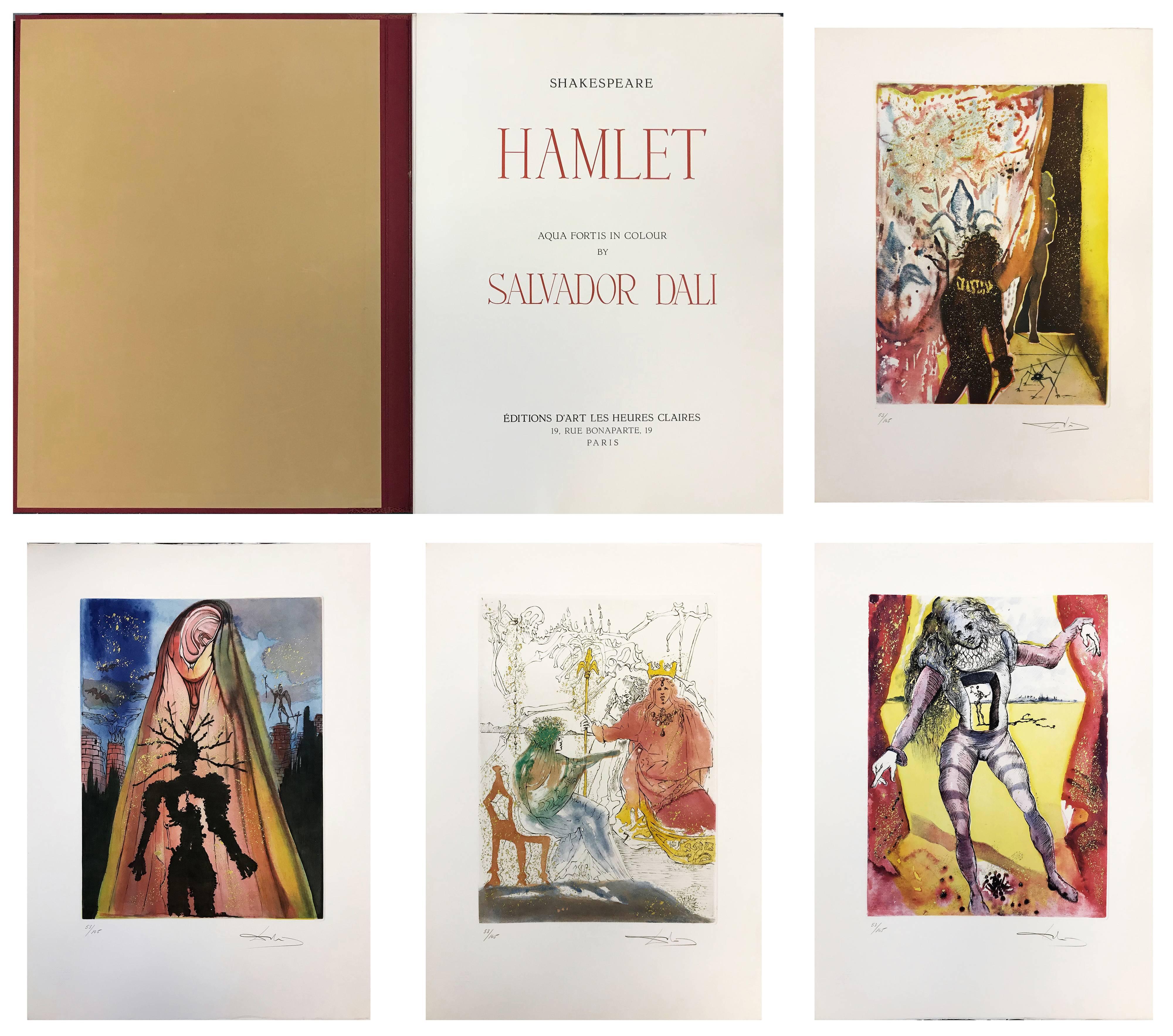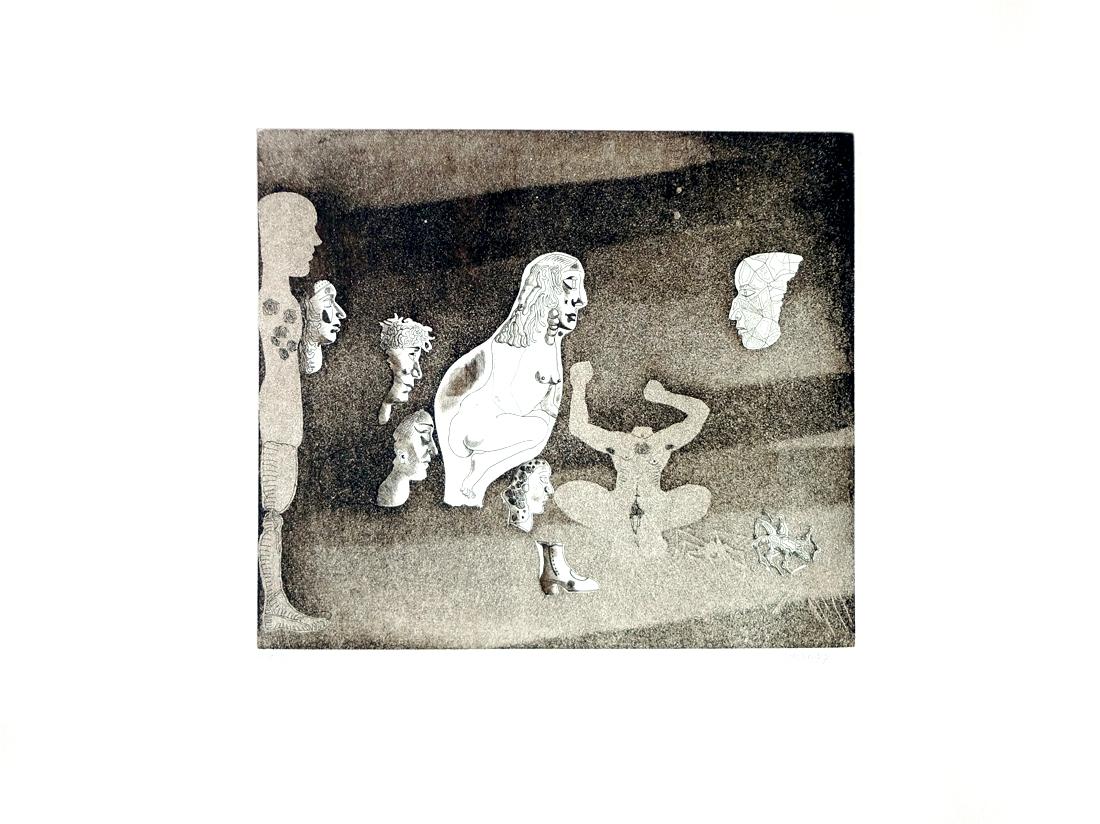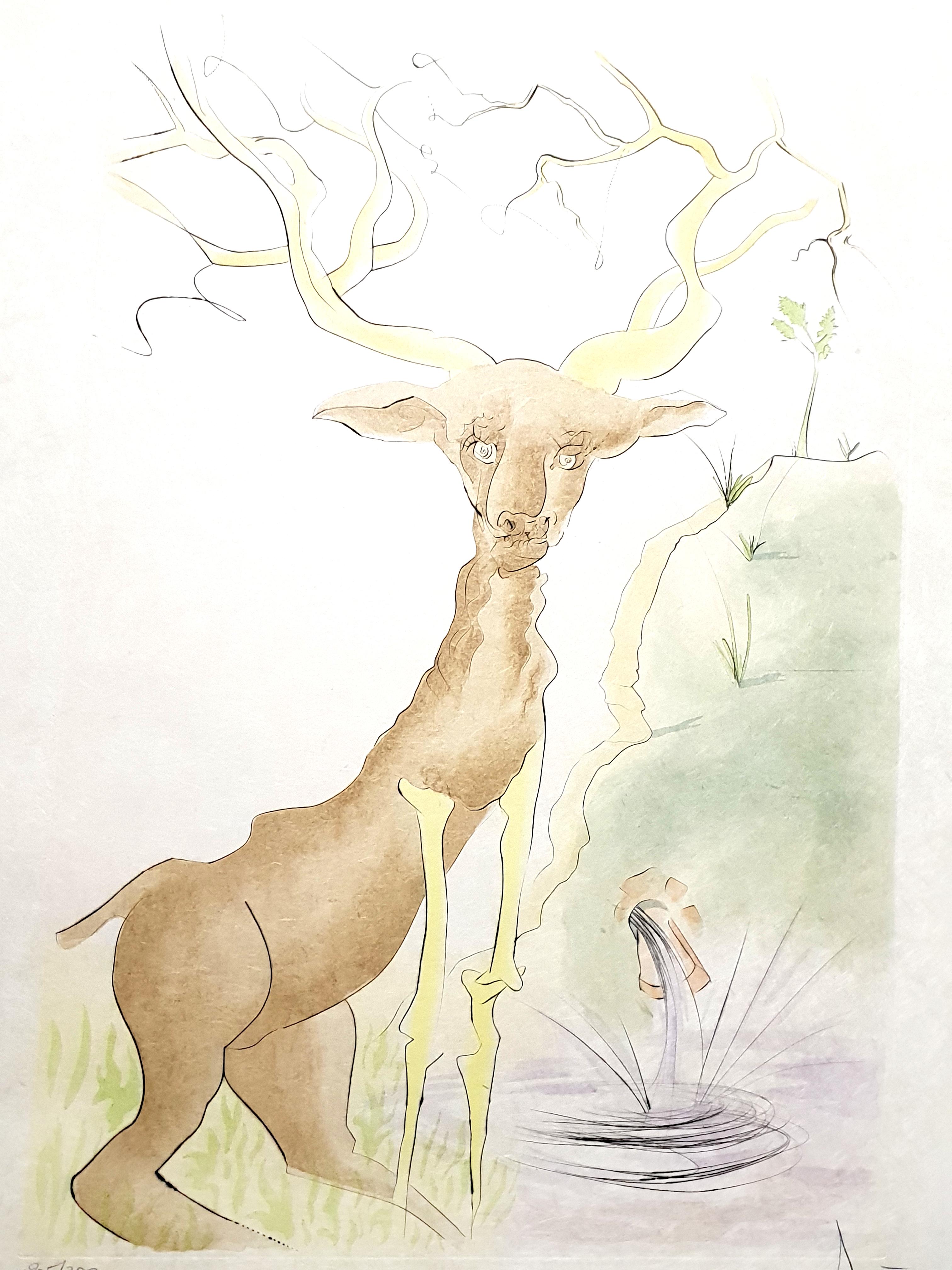Salvador DalíInferno: Canto 19 from The Divine Comedy1963
1963
About the Item
- Creator:Salvador Dalí (1904 - 1989, Spanish)
- Creation Year:1963
- Dimensions:Height: 19.25 in (48.9 cm)Width: 16.75 in (42.55 cm)
- Medium:
- Movement & Style:
- Period:
- Condition:
- Gallery Location:Washington, DC
- Reference Number:
Salvador Dalí
Instantly recognizable by his waxed, upturned mustache, the flamboyant Salvador Dalí is one of modern art’s most distinctive figures. He is also one of the icons of the 20-century avant-garde Surrealist movement, whose dreamlike images, drawn from the depths of the unconscious, he deployed in paintings, sculptures, prints and fashion, as well as in film collaborations with Luis Buñuel and Alfred Hitchcock.
Dalí was born in Figueres, Catalonia, and even as a youngster, displayed the sensitivity, sharp perception and vivid imagination that would later define his artworks. In these, he conjured childhood memories and employed religious symbols and Freudian imagery like staircases, keys and dripping candles to create unexpected, often shocking pieces.
Dalí's use of hyperrealism in conveying Surrealist symbols and concepts that subvert accepted notions of reality is epitomized in what is perhaps his most recognizable painting, The Persistence of Memory (1931), in which he depicts the fluidity of time through melting clocks, their forms inspired by Camembert cheese melting in the sun. His artistic genius, eccentric personality and eternal quest for fame made him a global celebrity.
“Each morning when I awake, I experience again a supreme pleasure,” he once said. “That of being Salvador Dalí.”
Find original Salvador Dalí paintings, prints, sculptures and other works on 1stDibs.
- ShippingRetrieving quote...Ships From: Washington, DC
- Return PolicyA return for this item may be initiated within 7 days of delivery.
- Dalinean ProphecyBy Salvador DalíLocated in Washington, DCArtist: Salvador Dali Title: Dalinean Prophecy Portfolio: Imaginations and Objects of the Future Medium: Engraving with color by...Category
1970s Surrealist Figurative Prints
MaterialsEngraving, Stencil
- Purgatory: Canto 25 from The Divine ComedyBy Salvador DalíLocated in Washington, DCArtist: Salvador Dali Medium: Woodblock engraving Title: Purgatory Canto 25 Portfolio: The Divine Comedy: Purgatory Year: 1963 Edition: 4765 Framed Size: 19 1/8" x 16 5/8" Sheet Size...Category
1960s Surrealist Figurative Prints
MaterialsEngraving
- Purgatory: Canto 24 from The Divine ComedyBy Salvador DalíLocated in Washington, DCArtist: Salvador Dali Medium: Woodblock engraving Title: Purgatory Canto 24 Portfolio: The Divine Comedy: Purgatory Year: 1963 Edition: 4765 Framed...Category
1960s Surrealist Figurative Prints
MaterialsEngraving
- Paradise: Canto 27 from The Divine ComedyBy Salvador DalíLocated in Washington, DCArtist: Salvador Dali Medium: Woodblock engraving Title: Paradise: Canto 27 Portfolio: The Divine Comedy: Paradise Year: 1963 Edition: 4765 Framed Si...Category
1960s Surrealist Figurative Prints
MaterialsEngraving
- Paradise: Canto 5 from The Divine ComedyBy Salvador DalíLocated in Washington, DCArtist: Salvador Dali Medium: Woodblock engraving Title: Paradise: Canto 5 Portfolio: The Divine Comedy: Paradise Year: 1963 Edition: 4765 Framed Size: 19 1/8...Category
1960s Surrealist Figurative Prints
MaterialsEngraving
- Purgatory: Canto 7 from The Divine ComedyBy Salvador DalíLocated in Washington, DCArtist: Salvador Dali Medium: Woodblock engraving Title: Purgatory: Canto 7 Portfolio: The Divine Comedy: Purgatory Year: 1963 Edition: 4765 Framed Size: 19 1/8" x 16 5/8" Sheet Size...Category
1960s Surrealist Figurative Prints
MaterialsEngraving
- HAMLET SUITEBy Salvador DalíLocated in Aventura, FLThis rare 10 piece series from 1973 is Dali's interpretation of Shakespeare's drama Hamlet. Dali paid homage to Shakespeare in several other works but this suite is considered to be ...Category
1970s Surrealist Figurative Prints
MaterialsLithograph, Engraving, Aquatint, Paper
- Jorge Castillo - EROTIC COMPOSITION Etching on paper Spanish SurrealismBy Jorge CastilloLocated in Madrid, MadridJorge Castillo - COMPOSICIÓN ERÓTICA (Erotic Composition) Date of creation: 1977 Medium: Etching on paper Edition: 75 + 20 E.A. Size: 50 x 65,5 cm Condition: In perfect conditions an...Category
1970s Surrealist Figurative Prints
MaterialsEngraving, Etching
- La Tombe du Père - Etching by Marc Chagall - 1923By Marc ChagallLocated in Roma, ITLa Tombe du Pére or The Father's Grave is a wonderful and rare dry-point, hand-signed in pencil on the lower right margin and hand-numbered on the lower left margin by Marc Chagall. ...Category
1920s Surrealist Figurative Prints
MaterialsDrypoint, Etching
- Salvador Dali - Le Cerf from Le Bestiaire de la Fontaine - Signed EngravingBy Salvador DalíLocated in Collonge Bellerive, Geneve, CHSALVADOR DALI Le Cerf se voyant dans l'eau from Le Bestiaire de la Fontaine 1974 Hand signed by Dali Edition: /250 The dimensions of the image are 22.8 x 15.7 inches on 31 x 23.2 in...Category
1970s Surrealist Figurative Prints
MaterialsDrypoint, Aquatint
- The Automobilist, from: My Life - Russian French Berlin Autobiography SurrealismBy Marc ChagallLocated in London, GBThis original etching with drypoint is hand signed in pencil by the artist "Marc Chagall" at the lower right margin. It is also hand numbered in pencil from the edition of 110, at t...Category
1920s Surrealist Figurative Prints
MaterialsDrypoint, Etching
- 'On Stage' — Mid-Century Surrealism, Atelier 17Located in Myrtle Beach, SCIan Hugo, 'On Stage', from the portfolio 'Ten Engravings'. engraving, 1946, edition 50. Signed, dated, titled, and numbered '22/50' in pencil. A fine impression, with delicate overall plate tone, on cream wove paper, the full sheet with margins (3 5/8 to 4 7/8 inches), in excellent condition. With the blind stamp 'madeleine-claude jobrack EDITIONS', in the bottom right margin. Matted to museum standards, unframed. Image size 5 7/8 x 3 7/8 inches (149 x 98 mm); sheet size 15 1/8 x 11 1/8 inches (384 x 283 mm). Ian Hugo originally created "Ten Engravings" in 1945, and the portfolio included a foreword by his partner and collaborator, Anais Nin. In 1978, Hugo republished the portfolio with Madeleine-Claude Jobrack, an American master printmaker who studied under Stanley William Hayter at Atelier 17, Paris, and with Johnny Friedlaender. When Jobrack returned to the United States she managed the Robert Blackburn Printmaking Studio in New York before opening her own printing studio, Madeleine-Claude Jobrak Editions. “The sign of the true artist is one who creates a complete universe, invents new plants, new animals, new figures to transfer to us a new vision of the universe in which dream and reality fuse. Ian Hugo's plants have eyes, the birds have the delicacy of dragonflies, their feathers have the shape of fans. Humor is apparent in every gesture. He uses a fine spider web to give a feeling of flight, speed, lightness. The body of a woman reveals the structure of a leaf, a plant. Wings are moving in a world unified by mythological themes. This is an animated world, humorous and levitating, elusive and decorative, which by its unique forms and shapes gives us the sensation of a rebirth, a liberation from the usual, the familiar, a visit to a new planet.” —Anais Nin, from the forward to the portfolio ‘Ten Engravings’ ABOUT THE ARTIST Ian Hugo was born Hugh Parker Guiler in Boston, Massachusetts, on February 15, 1898. His childhood was spent in Puerto Rico—a "tropical paradise," the memory of which stayed with him and surfaced in both his engravings and his films. He attended school in Scotland and graduated from Columbia University where he studied economics and literature. Hugo was working with the National City Bank when he met and married author Anais Nin in 1923. The couple moved to Paris the following year, where Nin's diary and Guiler's artistic aspirations flowered. Guiler feared his business associates would not understand his interests in art and music, let alone those of his wife, so he began a second, creative life as Ian Hugo. Ian and Anais moved to New York in 1939. The following year he took up engraving and etching, working at Stanley William Hayter’s experimental printmaking workshop Atelier 17, established at the New School for Social Research. Hugo began producing surreal images often used to illustrate Nin's books. For Nin, his unwavering love and financial support were indispensable—Hugo was the "fixed center, core... my home, my refuge" (Sept. 16, 1937, Nearer the Moon, The Unexpurgated Diary of Anais Nin, 1937-!939). Fictionalized portraits of Higo and Nin appear in Philip Kaufman's 1990 film drama of a literary love triangle, Henry & June. Inspired by comments that viewers saw motion in his engravings, Hugo took up filmmaking. He asked the avant-garde filmmaker Sasha Hammid for instruction but was told, "Use the camera yourself, make your own mistakes, make your own style." Hugo embarked on an exploration of the film medium as a vehicle to delve into his dreams, his unconscious, and his memories. Without a specific plan, He would collect resonant images, then reorder or superimpose them, seeking a sense of self-connection through the poetic juxtapositions he created. These intuitive explorations resembled the mystical evocations of his engravings, which he described in 1946 as "hieroglyphs of a language in which our unconscious is trying to convey important, urgent messages." In the underwater world of his film ‘Bells of Atlantis,’ the light originates from the world above the surface; it is otherworldly, out of place, yet essential. In ‘Jazz of Lights,’ the street lights of Times Square become in Nin's words, "an ephemeral flow of sensations." This flow that she also calls "phantasmagorical" had a crucial impact on Stan Brakhage, who said that without Jazz of Lights (1954), "there would have been no Anticipation of the Night" his autobiographical film which ushered in a new era of experimental modernist filmmaking. Hugo lived the last two decades of his life in a New York apartment high above street level. In the evenings, surrounded by an electrically illuminated man...Category
1940s Surrealist Figurative Prints
MaterialsEngraving






